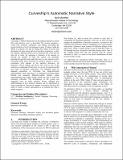Curveship’s Automatic Narrative Style
Author(s)
Montfort, Nick
DownloadMontfort curveship_fdg_camera_ready.pdf (371.1Kb)
OPEN_ACCESS_POLICY
Open Access Policy
Creative Commons Attribution-Noncommercial-Share Alike
Terms of use
Metadata
Show full item recordAbstract
Curveship, a Python framework for developing interactive fiction
(IF) with narrative style, is described. The system simulates a
world with locations, characters, and objects, providing the
typical facilities of an IF development system. To these it adds the
ability to generate text and to change the telling of events and
description of items using high-level narrative parameters, so that,
for instance, different actors can be focalized and events can be
told out of order. By assigning a character to be narrator or
moving the narrator in time, the system can determine
grammatical specifics and render the text in a new narrative style.
Curveship offers those interested in narrative systems a way to
experiment with changes in the narrative discourse; for
interactive fiction authors and those who wish to use of the
system as a component of their own, it is a way to create powerful
new types of narrative experiences. The templates used for
language generation in Curveship, the string-with-slots
representation, shows that there is a compromise between highly
flexible but extremely difficult-to-author abstract syntax
representations and simple strings, which are easy to write but
extremely inflexible. The development of the system has
suggested ways to refine narrative theory, offering new
understandings of how narrative distance can be understood as
being composed of lower-level changes in narrative and how the
order of events is better represented as an ordered tree than a
simple sequence.
Date issued
2011-06Department
Program in Media Arts and Sciences (Massachusetts Institute of Technology)Journal
FDG'11 Foundations of Digital Games, ACM
Publisher
Association for Computing Machinery
Citation
Montfort, Nick. "Curveship’s Automatic Narrative Style." The 6th International Conference on the Foundations of Digital Games (FDG'11), June 28-July 1, Bordeaux, France.
Version: Author's final manuscript
ISBN
978-1-4503-0804-5